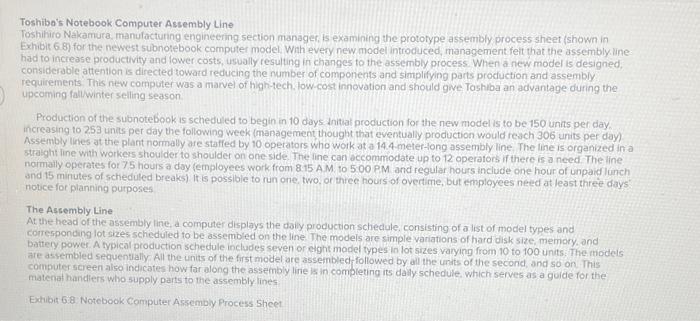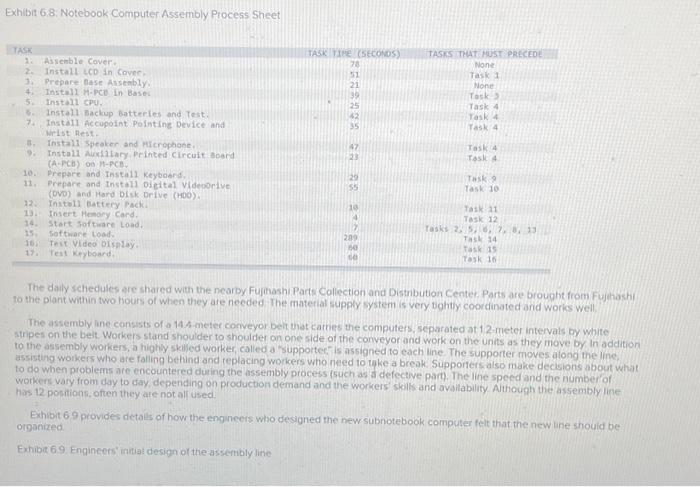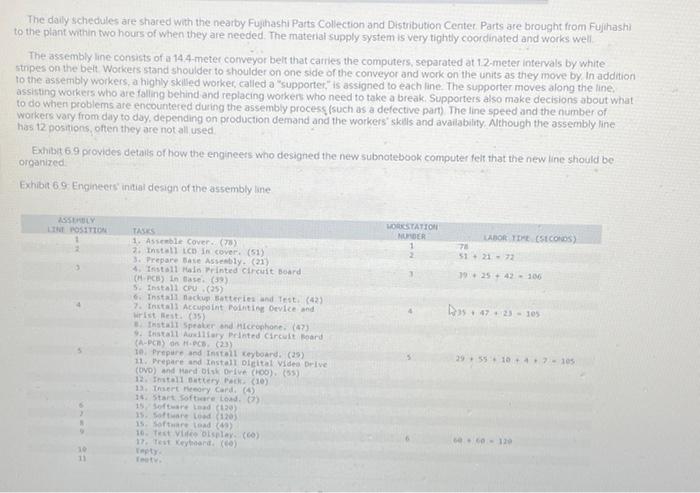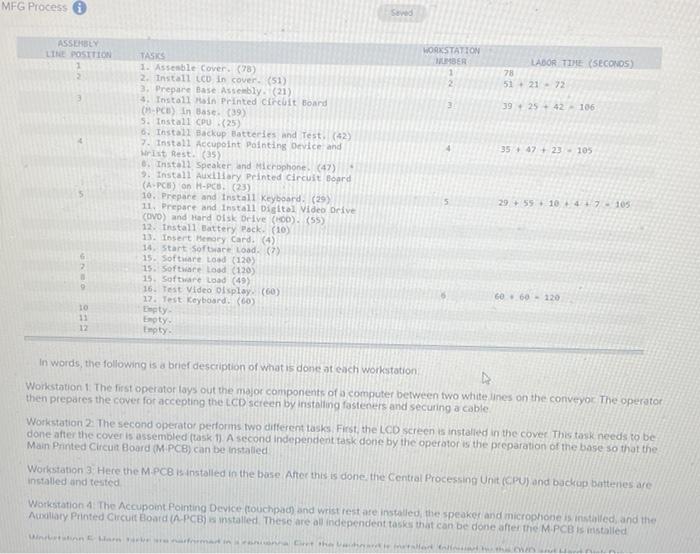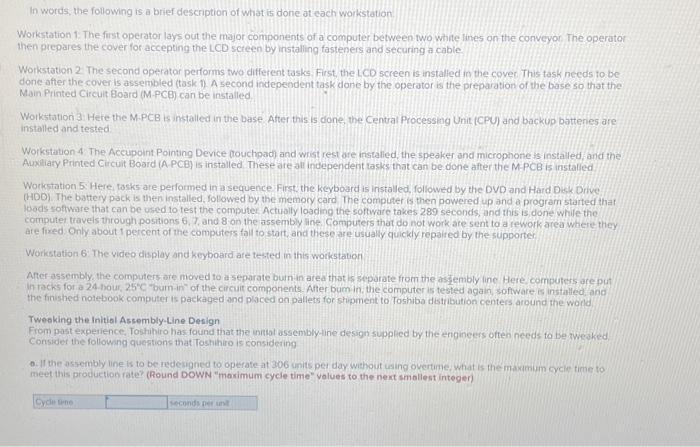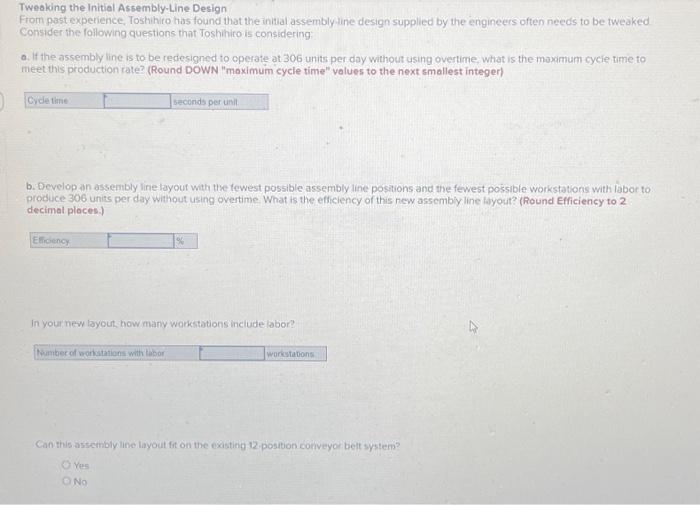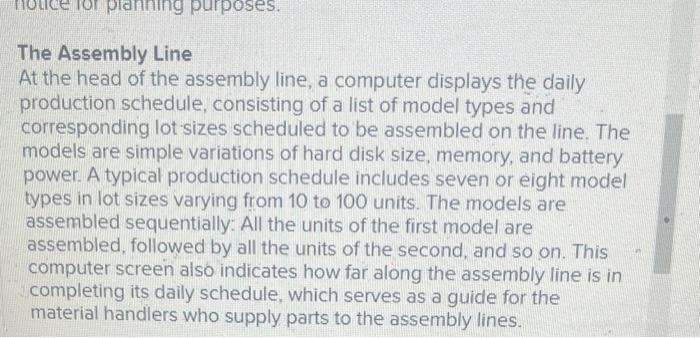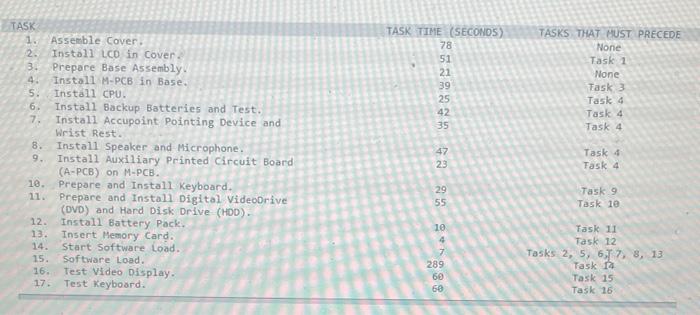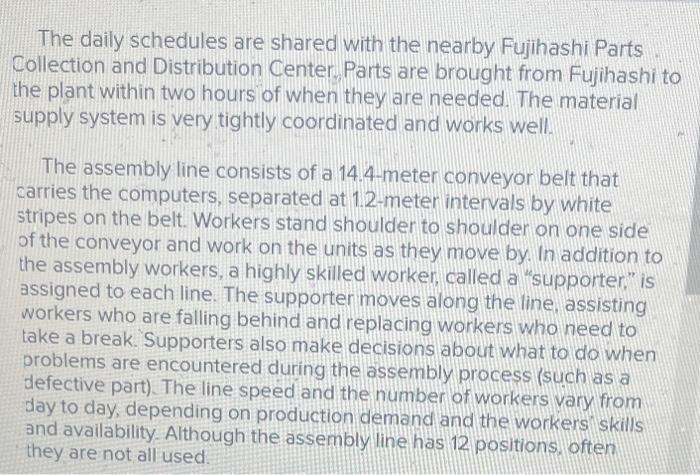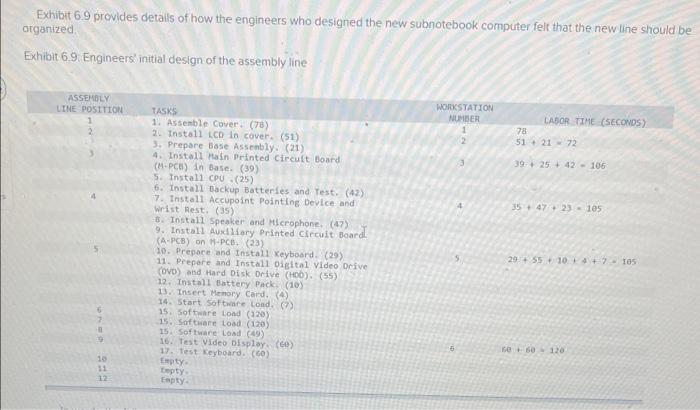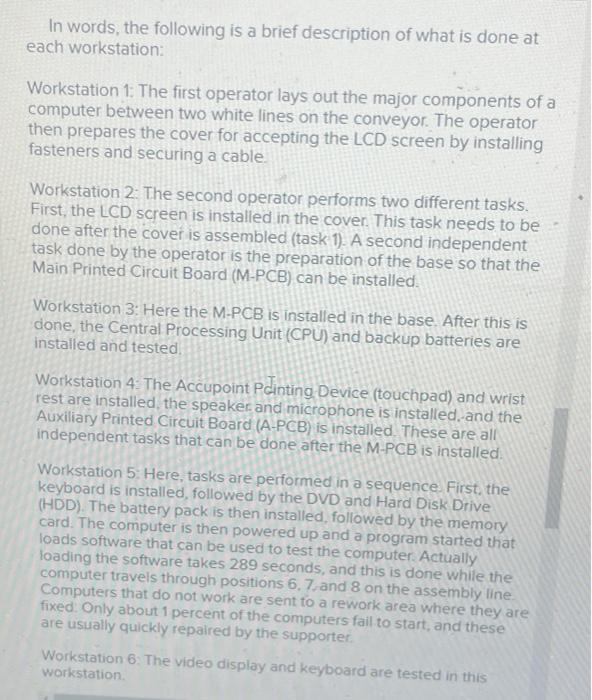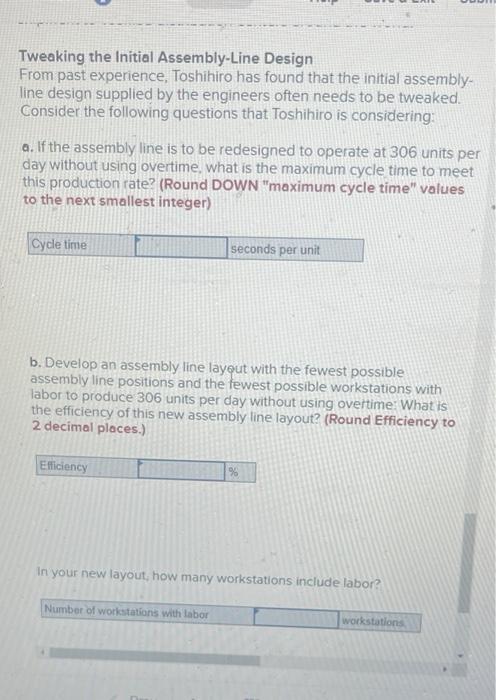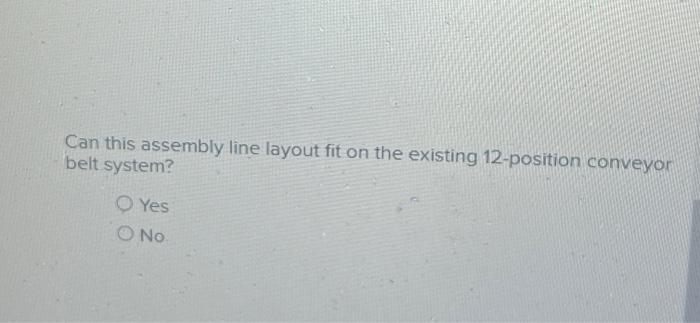Toshibo's Notebook Computer Assembly Line Toshihiro Nakamura, manufacturing engineering section manager, is examining the prototype assembly process sheet (shown in Exhibit 6 B) for the newest subnotebook computer model with every new model introduced, management felt that the assembly.line- had to increase productivity and lower costs, usually resulting in changes to the assembly process. When a new model is designed, considerable attention is directed toward reducing the number of components and simplifying parts production and assembly requirements. This new computer was a marvel of high-tech low.cost innovation and should give Toshiba an advantage during the upcoming fall/winter selling season Production of the subnotebook is scheduled to begin in 10 days Initial production for the new model is to be 150 units per day increasing to 253 units per day the following week (management thought that eventually production would reach 306 units per day) Assembly lines at the plant normally are staffed by 10 operators who work at a 14.4-meter-long assembly line The line is organized in a straight line with workers shoulder to shoulder on one side the line can accommodate up to 12 operators if there is a need. The line normally operates for 75 hours a day (employees work from 8:15 AM 10 500 PM and regular hours include one hour of unpaid lunch and 15 minutes of scheduled breaks) it is possible to run one two or three hours of overtime, but employees need at least three days notice for planning purposes The Assembly Line At the head of the assembly line, a computer displays the dally production schedule, consisting of a list of model types and corresponding lot sizes scheduled to be assembled on the line. The models are simple variations of hard disk size, memory, and battery power A typical production schedule includes seven or eight model types in lot sizes varying from 10 to 100 units. The models are assembled sequentially. All the units of the first model are assembled followed by all the units of the second and so on This computer screen also indicates how far along the assembly line is in completing its daily schedule, which serves as a guide for the matenat handlers who supply parts to the assembly lines Exhibit 68: Notebook Computer Assembly Process Sheet Exhibit 6.8 Notebook Computer Assembly Process Sheet TASK THE SECONDS) 78 21 39 25 52 35 TASKS THAT MOST PRECEDE None Task 1 None Tosk Task 4 Task 4 Task 4 TASK 2 Assemble Cover 2. Install LCD in Cover 3. Prepare Base Assembly 4 Install HPC in Bases 5 Install CPU Install Backup Batteries and test Install Accupoint Pointing Device and Wrist Rest Install Speaker and Microphone 9. Install Axillary Printed Circuit Board (APC) on PC 10. Prepare and Install keyboard 11. Prepart and Install ocital video rive (OVD) and Hard Disk Drive (H00) 12. Install battery Pack 13. Insert Memory Card 14. Start Software Load 15 ottivare Load 16) Toit Video Display 1. Test Keyboard 47 23 Task 4 Toska 29 S5 Task Task 10 10 4 289 10 co Task 11 Task 12 Tasks 25,6,7,8,13 Task 14 Task 15 York to The daily schedules are shared with the nearby Fujhash Parts Collection and Distribution Center Parts are brought from Fujihashi to the plant within two hours of when they are needed the material supply system is very tightly coordinated and works well The assembly line consists of 14.4 meter conveyor belt that cames the computers, separated at 12-meter intervals by white Stripes on the belt Workers stand shoulder to shoulder on one side of the conveyor and work on the units as they move by In addition to the assembly workers, a highly skilled worker, called a Supporter" is assigned to each line The supporter moves along the line assisting workers who are falling behind and replacing workers who need to take a break Supporters also make decisions about what to do when problems are encountered during the assembly process (such as a defective part). The line speed and the number of workers vary from day to day, depending on production demand and the workers skills and availability Although the assembly line has 12 positions often they are not all used Bhibit69 provides details of how the engineers who designed the new subnotebook computer felt that the new line should be Organized Exhibit 69. Engineers initial design of the assembly line The daily schedules are shared with the nearby Fujihashi Parts Collection and Distribution Center Parts are brought from Fujihash to the plant within two hours of when they are needed. The material supply system is very tightly coordinated and works well The assembly line consists of a 14.4-meter conveyor belt that carries the computers, separated at 12-meter intervals by white stripes on the belt Workers stand shoulder to shoulder on one side of the conveyor and work on the units as they move by. In addition to the assembly workers, a highly skilled worker called a supporter" is assigned to each line. The supporter moves along the line assisting workers who are falling behind and replacing workers who need to take a break. Supporters also make decisions about what to do when problems are encountered during the assembly process (such as a defective part) The line speed and the number of workers vary from day to day, depending on production demand and the workers skills and availability. Although the assembly line has 12 positions often they are not all used. Exhibit 6.9 provides details of how the engineers who designed the new subnotebook computer felt that the new line should be organized Exhibit 6 9 Engineers initial design of the assembly line ASSO THE POSITION LORSTATION MURDER LABOR THE SECONDS) 78 1925 +42106 +6723 - 105 TASKS 1. Assemble Cover (7) 2. Install LCD In cover (51) 3. Prepare Be Ably. (21) 4. Tristall Mal Printed Circuit Board CHPCB) in tase (39) 5: Install cpu (25) 6. Install nackup Batteries and Test (42) 7. Tal Accupoint Point Device and writest (35) Install Speaker and Microphone (47) 9. tristall Allary Printed Circuit Board (APD) (23) 10. Prepare and install keyboard (3) 11. Prepare and tastal olicial Video Drive (OVD) and Hard Disk Driver (HO) (55) 12. Thall outery (10) 1) The Hory Card (4) 16. Start Software Loud 15 Software load (120) 1. Software Lood (120) 15. Software toad (49) 16. Test v osplay (6) 17. Test Keyboard) ty 29 - 104.7105 - 110 MFG Process Seved ASSEMBE LE POSITION 1 WORKSTATION IMBER LABOR TIME (SECONOS) 78 51 +21 - 22 39 + 25 +42-106 35+47 + 23-105 TASKS 1. Assemble Cover (78) 2. Install coin cover (51) 3. Prepare Base Assembly (21) 3. Install in Printed Circuit Board (HPC) in Base (39) 5. Install CPU (25) 6. Install Backup Batteries and Test (42) 7. Install Accupoint Pointing Device and Wrist Rest (5) 6. Install Speaker and Microphone (47) 2. Install Auxiliary Printed Circuit Board (APC) on H-PC. (23) 10. Prepare and Install Keyboard (29) 11. Prepare and install Digital Video Drive (OVO) and Hard Disk Drive (00). (55) 12. Install Battery Pack (10) 13. Insert Henry Card (4) 14. Start Software Load (7) 15. Software Lood (120) 15. Software Lood (120) 15. Software Lad (49) 16. Test video oisplay. (60) 17. Test Keyboard (60) ty Empty Empty- 29 +55 10.417 - 105 - 6060120 to 11 12 In words the following is a brief description of what is done at each workstation Workstation 1. The first operator lays out the major components of a computer between two white lines on the conveyor The operator then prepares the cover for accepting the LCD screen by installing fasteners and securing a cable Workstation 2. The second operator performs two different tasks First the LCD screen is installed in the cover the task needs to be done after the cover is assembled task 1). A second independent task done by the operator is the preparation of the base so that the Main Printed Circuit Board (M PCB) can be installed Workstation 3 Here the M.PCB is installed in the base After this is done the Central Processing Unit (CPU) and backup battenes are installed and tested Workstation: The Accupoint Pointing Device (touchpad) and wrist restare installed the speaker and microphone is installed, and the Auxiliary Printed Circuit Board (PCB) is installed. These are all independent tasks that can be done after the M.PCB is installed Unit Latin the In words, the following is a brief description of what is done at each workstation Workstation 1. The first operator lays out the major components of a computer between two white lines on the conveyon The operator then prepares the cover for accepting the LCD screen by installing fasteners and securing a cable Workstation 2. The second operator performs two different tasks. First, the LCD screen is installed in the cover This task needs to be done after the cover is assembled task 1) A second independent task done by the operator is the preparation of the base so that the Main Printed Circuit Board (M-PCB) can be installed Workstation as Here the M.PCB is installed in the base After this is done, the Central Processing Unit (CPU) and backup battenes are installed and tested Workstation 4 The Aceupoint Pointing Device Grouchod) and wrist rest are installed the speaker and microphone is installed and the Auxiliary Printed Circuit Board (A PCB) is installed. These are all independent tasks that can be done after the M PCB is installed Workstation 5 Here tasks are performed in a sequence First, the keyboard is installed, followed by the DVD and Hard Disk Drive (HDD) The battery pack is then installed followed by the memory card The computer is then powered up and a program started that Joods software that can be used to test the computer Actually loading the software takes 289 seconds, and this is done while the computer travels through positions 6.7 and 8 on the assembly line Computers that do not work are sent to a rework area where they are fixed Only about 1 percent of the computers fail to start and these are usually quickly repaired by the supporter Workstation 6 The video display and keyboard are tested in this workstation After assembly, the computers are moved to a separate bun in area that is separate from the asjembly ine Here computers are put In racks for a 24-hour, 25C "bumin of the circuit components. Afterbum in the computer is tested again software is installed, and the finished notebook computer is packaged and placed on pallets for shipment to Toshiba distribution centers around the world Tweaking the initial Assembly Line Design From past experience, Toshihiro has found that the total assembly-line design supplied by the engineers often needs to be tweaked Consider the following questions that Toshihiro is considering of the assembly line is to be redesigned to operate at 306 units per day without using overtime. What is the maximum cycle time to meet this production rate (Round DOWN maximum cycle time values to the next smallest integer Cyclone econds per Tweaking the Initial Assembly-Line Design From past experience, Toshihiro has found that the antial assembly line design supplled by the engineers often needs to be tweaked Consider the following questions that Toshihiro is considering a. If the assembly line is to be redesigned to operate at 306 units per day without using overtime, what is the maximum cycle time to meet this production rate? (Round DOWN "maximum cycle time" values to the next smallest integer) ) Cyde tenie seconds per unit b. Develop an assembly line layout with the tewest possible assembly line positions and the fewest possible workstations with labor to produce 306 units per day without using overtime What is the efficiency of this new assembly line layout? (Round Efficiency to 2 decimal places) Endency In your new layout how many workstations include labor Number of workstations with por workstations Can this assembly line layout fit on the existing 12 position conveyor belt system? Yes NO Saved Help Save & Exit Submi Toshiba's Notebook Computer Assembly Line Toshihiro Nakamura, manufacturing engineering section manager, is examining the prototype assembly process sheet (shown in Exhibit 6.8) for the newest subnotebook computer model. With every new model introduced, management felt that the assembly line had to increase productivity and lower costs, usually resulting in changes to the assembly process. When a new model is designed, considerable attention is directed toward reducing the number of components and simplifying parts production and assembly requirements. This new computer was a marvel of high-tech, low-cost innovation and should give Toshiba an advantage during the upcoming fall/winter selling season. Production of the subnotebook is scheduled to begin in 10 days. Initial production for the new model is to be 150 units per day increasing to 253 units per day the following week (management thought that eventually production would reach 306 units per day). Assembly lines at the plant normally are staffed by 10 operators who work at a 14.4-meter-long assembly line. The line is organized in a straight line with workers shoulder to shoulder on one side. The line can accommodate up to 12 operators if there is a need. The line normally operates for 7.5 hours a day (employees work from 8:15 A.M. to 5:00 P.M. and regular hours include one hour of unpaid lunch and 15 minutes of scheduled breaks). It is possible to run one two on three hours of overtime, but employees need at least three days notice for planning purposes. planning purposes. The Assembly Line At the head of the assembly line, a computer displays the daily production schedule, consisting of a list of model types and corresponding lot sizes scheduled to be assembled on the line. The models are simple variations of hard disk size, memory, and battery power. A typical production schedule includes seven or eight model types in lot sizes varying from 10 to 100 units. The models are assembled sequentially: All the units of the first model are assembled, followed by all the units of the second, and so on. This computer screen also indicates how far along the assembly line is in completing its daily schedule, which serves as a guide for the material handlers who supply parts to the assembly lines. TASK TIME (SECONDS) 78 51 21 39 25 42 35 TASKS THAT HUST PRECEDE None Task 1 None Task 3 Task 4 Task 4 Task 4 TASK 1. Assemble Cover 2. Install LCD in Cover 3. Prepare Base Assembly 4. Install M-PCB in Base. 5. Install CPU. 6. Install Backup Batteries and Test. 7. Install Accupoint Pointing Device and Wrist Rest. 8. Install Speaker and Microphone. 9. Install Auxiliary Printed Circuit Board (A-PCB) on M-PCB. 18 Prepare and Install keyboard. 11. Prepare and Install Digital VideoDrive (DVD) and Hard Disk Drive (HDD). 12 Install Battery Pack. 13. Insert Memory Card. 14. Start Software Load. Software Load. 16. Test Video Display. 17. Test Keyboard w79% 8 47 23 Task 4 Task 4 29 55 Task 9 Task 10 4 15. 289 60 60 Task 11 Task 12 Tasks 2, 5, 6, 7, 8, 13 Task 14 Task 15 Task 16 The daily schedules are shared with the nearby Fujihashi Parts Collection and Distribution Center Parts are brought from Fujihashi to the plant within two hours of when they are needed. The material supply system is very tightly coordinated and works well. The assembly line consists of a 14.4-meter conveyor belt that carries the computers, separated at 1.2-meter intervals by white stripes on the belt. Workers stand shoulder to shoulder on one side of the conveyor and work on the units as they move by. In addition to the assembly workers, a highly skilled worker, called a "supporter." is assigned to each line. The supporter moves along the line, assisting workers who are falling behind and replacing workers who need to take a break. Supporters also make decisions about what to do when problems are encountered during the assembly process (such as a defective part) The line speed and the number of workers vary from day to day, depending on production demand and the workers skills and availability. Although the assembly line has 12 positions often they are not all used. Exhibit 6.9 provides details of how the engineers who designed the new subnotebook computer felt that the new line should be organized Exhibit 6.9. Engineers' initial design of the assembly line ASSEMBLY LINE POSITION WORKSTATION NUMBER LABOR TIME (SECONDS) 78 51 + 21 72 39 + 25 + 42 - 106 35 + 47+23 - 105 TASKS 1. Assemble Cover (78) 2. Install LCD In cover (51) 3. Prepare Base Assembly (21) 4. Install Main Printed Circuit Board (M-PCB) in Base (39) 5. Install CPU (25) 6. Install Backup Batteries and Test. (42) 7. Install Accupoint Pointing Device and Wrist Rest. (35) 3. Install Speaker and Microphone (47) 9. Install Auxiliary Printed Circuit Board (A-PCB) on H.PCB. (23) 10. Prepare and Install Keyboard (29) 11. Prepare and Install Digital Video Drive (OVD) and Hard Disk Drive (HD) (55) 12. Install Battery Pack (10) 13. Insert Memory Card (4) 14. Start Software Lond. () 15. Software Load (120) 15. Software Load (120) 15. Software Load (49) 1. Test Video Display (60) 17. Test Keyboard. (60) tept. Empty Empty 29 + 55+ 10 +7 - 105 60+ 60 - 120 10 12 In words, the following is a brief description of what is done at each workstation: Workstation 1: The first operator lays out the major components of a computer between two white lines on the conveyor. The operator then prepares the cover for accepting the LCD screen by installing fasteners and securing a cable. Workstation 2. The second operator performs two different tasks. First, the LCD screen is installed in the cover. This task needs to be done after the cover is assembled (task 1). A second independent task done by the operator is the preparation of the base so that the Main Printed Circuit Board (M-PCB) can be installed. Workstation 3: Here the M-PCB is installed in the base. After this is done, the Central Processing Unit (CPU) and backup batteries are installed and tested, Workstation 4: The Accupoint Painting Device (touchpad) and wrist rest are installed, the speaker and microphone is installed, and the Auxiliary Printed Circuit Board (A-PCB) is installed. These are all independent tasks that can be done after the M-PCB is installed. Workstation 5: Here, tasks are performed in a sequence. First, the keyboard is installed, followed by the DVD and Hard Disk Drive (HDD). The battery pack is then installed, followed by the memory card. The computer is then powered up and a program started that loads software that can be used to test the computer. Actually loading the software takes 289 seconds, and this is done while the computer travels through positions 6, 7 and 8 on the assembly line. Computers that do not work are sent to a rework area where they are fixed. Only about 1 percent of the computers fail to start, and these are usually quickly repaired by the supporter Workstation 6: The video display and keyboard are tested in this workstation Tweaking the Initial Assembly-Line Design From past experience, Toshihiro has found that the initial assembly. line design supplied by the engineers often needs to be tweaked. Consider the following questions that Toshihiro is considering: a. If the assembly line is to be redesigned to operate at 306 units per day without using overtime, what is the maximum cycle time to meet this production rate? (Round DOWN "maximum cycle time" values to the next smallest integer) Cycle time seconds per unit b. Develop an assembly line layout with the fewest possible assembly line positions and the fewest possible workstations with labor to produce 306 units per day without using overtime: What is the efficiency of this new assembly line layout? (Round Efficiency to 2 decimal places.) Efficiency 9 In your new layout, how many workstations include labor? Number of workstations with labor workstations Can this assembly line layout fit on the existing 12-position conveyor belt system? Yes . Toshibo's Notebook Computer Assembly Line Toshihiro Nakamura, manufacturing engineering section manager, is examining the prototype assembly process sheet (shown in Exhibit 6 B) for the newest subnotebook computer model with every new model introduced, management felt that the assembly.line- had to increase productivity and lower costs, usually resulting in changes to the assembly process. When a new model is designed, considerable attention is directed toward reducing the number of components and simplifying parts production and assembly requirements. This new computer was a marvel of high-tech low.cost innovation and should give Toshiba an advantage during the upcoming fall/winter selling season Production of the subnotebook is scheduled to begin in 10 days Initial production for the new model is to be 150 units per day increasing to 253 units per day the following week (management thought that eventually production would reach 306 units per day) Assembly lines at the plant normally are staffed by 10 operators who work at a 14.4-meter-long assembly line The line is organized in a straight line with workers shoulder to shoulder on one side the line can accommodate up to 12 operators if there is a need. The line normally operates for 75 hours a day (employees work from 8:15 AM 10 500 PM and regular hours include one hour of unpaid lunch and 15 minutes of scheduled breaks) it is possible to run one two or three hours of overtime, but employees need at least three days notice for planning purposes The Assembly Line At the head of the assembly line, a computer displays the dally production schedule, consisting of a list of model types and corresponding lot sizes scheduled to be assembled on the line. The models are simple variations of hard disk size, memory, and battery power A typical production schedule includes seven or eight model types in lot sizes varying from 10 to 100 units. The models are assembled sequentially. All the units of the first model are assembled followed by all the units of the second and so on This computer screen also indicates how far along the assembly line is in completing its daily schedule, which serves as a guide for the matenat handlers who supply parts to the assembly lines Exhibit 68: Notebook Computer Assembly Process Sheet Exhibit 6.8 Notebook Computer Assembly Process Sheet TASK THE SECONDS) 78 21 39 25 52 35 TASKS THAT MOST PRECEDE None Task 1 None Tosk Task 4 Task 4 Task 4 TASK 2 Assemble Cover 2. Install LCD in Cover 3. Prepare Base Assembly 4 Install HPC in Bases 5 Install CPU Install Backup Batteries and test Install Accupoint Pointing Device and Wrist Rest Install Speaker and Microphone 9. Install Axillary Printed Circuit Board (APC) on PC 10. Prepare and Install keyboard 11. Prepart and Install ocital video rive (OVD) and Hard Disk Drive (H00) 12. Install battery Pack 13. Insert Memory Card 14. Start Software Load 15 ottivare Load 16) Toit Video Display 1. Test Keyboard 47 23 Task 4 Toska 29 S5 Task Task 10 10 4 289 10 co Task 11 Task 12 Tasks 25,6,7,8,13 Task 14 Task 15 York to The daily schedules are shared with the nearby Fujhash Parts Collection and Distribution Center Parts are brought from Fujihashi to the plant within two hours of when they are needed the material supply system is very tightly coordinated and works well The assembly line consists of 14.4 meter conveyor belt that cames the computers, separated at 12-meter intervals by white Stripes on the belt Workers stand shoulder to shoulder on one side of the conveyor and work on the units as they move by In addition to the assembly workers, a highly skilled worker, called a Supporter" is assigned to each line The supporter moves along the line assisting workers who are falling behind and replacing workers who need to take a break Supporters also make decisions about what to do when problems are encountered during the assembly process (such as a defective part). The line speed and the number of workers vary from day to day, depending on production demand and the workers skills and availability Although the assembly line has 12 positions often they are not all used Bhibit69 provides details of how the engineers who designed the new subnotebook computer felt that the new line should be Organized Exhibit 69. Engineers initial design of the assembly line The daily schedules are shared with the nearby Fujihashi Parts Collection and Distribution Center Parts are brought from Fujihash to the plant within two hours of when they are needed. The material supply system is very tightly coordinated and works well The assembly line consists of a 14.4-meter conveyor belt that carries the computers, separated at 12-meter intervals by white stripes on the belt Workers stand shoulder to shoulder on one side of the conveyor and work on the units as they move by. In addition to the assembly workers, a highly skilled worker called a supporter" is assigned to each line. The supporter moves along the line assisting workers who are falling behind and replacing workers who need to take a break. Supporters also make decisions about what to do when problems are encountered during the assembly process (such as a defective part) The line speed and the number of workers vary from day to day, depending on production demand and the workers skills and availability. Although the assembly line has 12 positions often they are not all used. Exhibit 6.9 provides details of how the engineers who designed the new subnotebook computer felt that the new line should be organized Exhibit 6 9 Engineers initial design of the assembly line ASSO THE POSITION LORSTATION MURDER LABOR THE SECONDS) 78 1925 +42106 +6723 - 105 TASKS 1. Assemble Cover (7) 2. Install LCD In cover (51) 3. Prepare Be Ably. (21) 4. Tristall Mal Printed Circuit Board CHPCB) in tase (39) 5: Install cpu (25) 6. Install nackup Batteries and Test (42) 7. Tal Accupoint Point Device and writest (35) Install Speaker and Microphone (47) 9. tristall Allary Printed Circuit Board (APD) (23) 10. Prepare and install keyboard (3) 11. Prepare and tastal olicial Video Drive (OVD) and Hard Disk Driver (HO) (55) 12. Thall outery (10) 1) The Hory Card (4) 16. Start Software Loud 15 Software load (120) 1. Software Lood (120) 15. Software toad (49) 16. Test v osplay (6) 17. Test Keyboard) ty 29 - 104.7105 - 110 MFG Process Seved ASSEMBE LE POSITION 1 WORKSTATION IMBER LABOR TIME (SECONOS) 78 51 +21 - 22 39 + 25 +42-106 35+47 + 23-105 TASKS 1. Assemble Cover (78) 2. Install coin cover (51) 3. Prepare Base Assembly (21) 3. Install in Printed Circuit Board (HPC) in Base (39) 5. Install CPU (25) 6. Install Backup Batteries and Test (42) 7. Install Accupoint Pointing Device and Wrist Rest (5) 6. Install Speaker and Microphone (47) 2. Install Auxiliary Printed Circuit Board (APC) on H-PC. (23) 10. Prepare and Install Keyboard (29) 11. Prepare and install Digital Video Drive (OVO) and Hard Disk Drive (00). (55) 12. Install Battery Pack (10) 13. Insert Henry Card (4) 14. Start Software Load (7) 15. Software Lood (120) 15. Software Lood (120) 15. Software Lad (49) 16. Test video oisplay. (60) 17. Test Keyboard (60) ty Empty Empty- 29 +55 10.417 - 105 - 6060120 to 11 12 In words the following is a brief description of what is done at each workstation Workstation 1. The first operator lays out the major components of a computer between two white lines on the conveyor The operator then prepares the cover for accepting the LCD screen by installing fasteners and securing a cable Workstation 2. The second operator performs two different tasks First the LCD screen is installed in the cover the task needs to be done after the cover is assembled task 1). A second independent task done by the operator is the preparation of the base so that the Main Printed Circuit Board (M PCB) can be installed Workstation 3 Here the M.PCB is installed in the base After this is done the Central Processing Unit (CPU) and backup battenes are installed and tested Workstation: The Accupoint Pointing Device (touchpad) and wrist restare installed the speaker and microphone is installed, and the Auxiliary Printed Circuit Board (PCB) is installed. These are all independent tasks that can be done after the M.PCB is installed Unit Latin the In words, the following is a brief description of what is done at each workstation Workstation 1. The first operator lays out the major components of a computer between two white lines on the conveyon The operator then prepares the cover for accepting the LCD screen by installing fasteners and securing a cable Workstation 2. The second operator performs two different tasks. First, the LCD screen is installed in the cover This task needs to be done after the cover is assembled task 1) A second independent task done by the operator is the preparation of the base so that the Main Printed Circuit Board (M-PCB) can be installed Workstation as Here the M.PCB is installed in the base After this is done, the Central Processing Unit (CPU) and backup battenes are installed and tested Workstation 4 The Aceupoint Pointing Device Grouchod) and wrist rest are installed the speaker and microphone is installed and the Auxiliary Printed Circuit Board (A PCB) is installed. These are all independent tasks that can be done after the M PCB is installed Workstation 5 Here tasks are performed in a sequence First, the keyboard is installed, followed by the DVD and Hard Disk Drive (HDD) The battery pack is then installed followed by the memory card The computer is then powered up and a program started that Joods software that can be used to test the computer Actually loading the software takes 289 seconds, and this is done while the computer travels through positions 6.7 and 8 on the assembly line Computers that do not work are sent to a rework area where they are fixed Only about 1 percent of the computers fail to start and these are usually quickly repaired by the supporter Workstation 6 The video display and keyboard are tested in this workstation After assembly, the computers are moved to a separate bun in area that is separate from the asjembly ine Here computers are put In racks for a 24-hour, 25C "bumin of the circuit components. Afterbum in the computer is tested again software is installed, and the finished notebook computer is packaged and placed on pallets for shipment to Toshiba distribution centers around the world Tweaking the initial Assembly Line Design From past experience, Toshihiro has found that the total assembly-line design supplied by the engineers often needs to be tweaked Consider the following questions that Toshihiro is considering of the assembly line is to be redesigned to operate at 306 units per day without using overtime. What is the maximum cycle time to meet this production rate (Round DOWN maximum cycle time values to the next smallest integer Cyclone econds per Tweaking the Initial Assembly-Line Design From past experience, Toshihiro has found that the antial assembly line design supplled by the engineers often needs to be tweaked Consider the following questions that Toshihiro is considering a. If the assembly line is to be redesigned to operate at 306 units per day without using overtime, what is the maximum cycle time to meet this production rate? (Round DOWN "maximum cycle time" values to the next smallest integer) ) Cyde tenie seconds per unit b. Develop an assembly line layout with the tewest possible assembly line positions and the fewest possible workstations with labor to produce 306 units per day without using overtime What is the efficiency of this new assembly line layout? (Round Efficiency to 2 decimal places) Endency In your new layout how many workstations include labor Number of workstations with por workstations Can this assembly line layout fit on the existing 12 position conveyor belt system? Yes NO Saved Help Save & Exit Submi Toshiba's Notebook Computer Assembly Line Toshihiro Nakamura, manufacturing engineering section manager, is examining the prototype assembly process sheet (shown in Exhibit 6.8) for the newest subnotebook computer model. With every new model introduced, management felt that the assembly line had to increase productivity and lower costs, usually resulting in changes to the assembly process. When a new model is designed, considerable attention is directed toward reducing the number of components and simplifying parts production and assembly requirements. This new computer was a marvel of high-tech, low-cost innovation and should give Toshiba an advantage during the upcoming fall/winter selling season. Production of the subnotebook is scheduled to begin in 10 days. Initial production for the new model is to be 150 units per day increasing to 253 units per day the following week (management thought that eventually production would reach 306 units per day). Assembly lines at the plant normally are staffed by 10 operators who work at a 14.4-meter-long assembly line. The line is organized in a straight line with workers shoulder to shoulder on one side. The line can accommodate up to 12 operators if there is a need. The line normally operates for 7.5 hours a day (employees work from 8:15 A.M. to 5:00 P.M. and regular hours include one hour of unpaid lunch and 15 minutes of scheduled breaks). It is possible to run one two on three hours of overtime, but employees need at least three days notice for planning purposes. planning purposes. The Assembly Line At the head of the assembly line, a computer displays the daily production schedule, consisting of a list of model types and corresponding lot sizes scheduled to be assembled on the line. The models are simple variations of hard disk size, memory, and battery power. A typical production schedule includes seven or eight model types in lot sizes varying from 10 to 100 units. The models are assembled sequentially: All the units of the first model are assembled, followed by all the units of the second, and so on. This computer screen also indicates how far along the assembly line is in completing its daily schedule, which serves as a guide for the material handlers who supply parts to the assembly lines. TASK TIME (SECONDS) 78 51 21 39 25 42 35 TASKS THAT HUST PRECEDE None Task 1 None Task 3 Task 4 Task 4 Task 4 TASK 1. Assemble Cover 2. Install LCD in Cover 3. Prepare Base Assembly 4. Install M-PCB in Base. 5. Install CPU. 6. Install Backup Batteries and Test. 7. Install Accupoint Pointing Device and Wrist Rest. 8. Install Speaker and Microphone. 9. Install Auxiliary Printed Circuit Board (A-PCB) on M-PCB. 18 Prepare and Install keyboard. 11. Prepare and Install Digital VideoDrive (DVD) and Hard Disk Drive (HDD). 12 Install Battery Pack. 13. Insert Memory Card. 14. Start Software Load. Software Load. 16. Test Video Display. 17. Test Keyboard w79% 8 47 23 Task 4 Task 4 29 55 Task 9 Task 10 4 15. 289 60 60 Task 11 Task 12 Tasks 2, 5, 6, 7, 8, 13 Task 14 Task 15 Task 16 The daily schedules are shared with the nearby Fujihashi Parts Collection and Distribution Center Parts are brought from Fujihashi to the plant within two hours of when they are needed. The material supply system is very tightly coordinated and works well. The assembly line consists of a 14.4-meter conveyor belt that carries the computers, separated at 1.2-meter intervals by white stripes on the belt. Workers stand shoulder to shoulder on one side of the conveyor and work on the units as they move by. In addition to the assembly workers, a highly skilled worker, called a "supporter." is assigned to each line. The supporter moves along the line, assisting workers who are falling behind and replacing workers who need to take a break. Supporters also make decisions about what to do when problems are encountered during the assembly process (such as a defective part) The line speed and the number of workers vary from day to day, depending on production demand and the workers skills and availability. Although the assembly line has 12 positions often they are not all used. Exhibit 6.9 provides details of how the engineers who designed the new subnotebook computer felt that the new line should be organized Exhibit 6.9. Engineers' initial design of the assembly line ASSEMBLY LINE POSITION WORKSTATION NUMBER LABOR TIME (SECONDS) 78 51 + 21 72 39 + 25 + 42 - 106 35 + 47+23 - 105 TASKS 1. Assemble Cover (78) 2. Install LCD In cover (51) 3. Prepare Base Assembly (21) 4. Install Main Printed Circuit Board (M-PCB) in Base (39) 5. Install CPU (25) 6. Install Backup Batteries and Test. (42) 7. Install Accupoint Pointing Device and Wrist Rest. (35) 3. Install Speaker and Microphone (47) 9. Install Auxiliary Printed Circuit Board (A-PCB) on H.PCB. (23) 10. Prepare and Install Keyboard (29) 11. Prepare and Install Digital Video Drive (OVD) and Hard Disk Drive (HD) (55) 12. Install Battery Pack (10) 13. Insert Memory Card (4) 14. Start Software Lond. () 15. Software Load (120) 15. Software Load (120) 15. Software Load (49) 1. Test Video Display (60) 17. Test Keyboard. (60) tept. Empty Empty 29 + 55+ 10 +7 - 105 60+ 60 - 120 10 12 In words, the following is a brief description of what is done at each workstation: Workstation 1: The first operator lays out the major components of a computer between two white lines on the conveyor. The operator then prepares the cover for accepting the LCD screen by installing fasteners and securing a cable. Workstation 2. The second operator performs two different tasks. First, the LCD screen is installed in the cover. This task needs to be done after the cover is assembled (task 1). A second independent task done by the operator is the preparation of the base so that the Main Printed Circuit Board (M-PCB) can be installed. Workstation 3: Here the M-PCB is installed in the base. After this is done, the Central Processing Unit (CPU) and backup batteries are installed and tested, Workstation 4: The Accupoint Painting Device (touchpad) and wrist rest are installed, the speaker and microphone is installed, and the Auxiliary Printed Circuit Board (A-PCB) is installed. These are all independent tasks that can be done after the M-PCB is installed. Workstation 5: Here, tasks are performed in a sequence. First, the keyboard is installed, followed by the DVD and Hard Disk Drive (HDD). The battery pack is then installed, followed by the memory card. The computer is then powered up and a program started that loads software that can be used to test the computer. Actually loading the software takes 289 seconds, and this is done while the computer travels through positions 6, 7 and 8 on the assembly line. Computers that do not work are sent to a rework area where they are fixed. Only about 1 percent of the computers fail to start, and these are usually quickly repaired by the supporter Workstation 6: The video display and keyboard are tested in this workstation Tweaking the Initial Assembly-Line Design From past experience, Toshihiro has found that the initial assembly. line design supplied by the engineers often needs to be tweaked. Consider the following questions that Toshihiro is considering: a. If the assembly line is to be redesigned to operate at 306 units per day without using overtime, what is the maximum cycle time to meet this production rate? (Round DOWN "maximum cycle time" values to the next smallest integer) Cycle time seconds per unit b. Develop an assembly line layout with the fewest possible assembly line positions and the fewest possible workstations with labor to produce 306 units per day without using overtime: What is the efficiency of this new assembly line layout? (Round Efficiency to 2 decimal places.) Efficiency 9 In your new layout, how many workstations include labor? Number of workstations with labor workstations Can this assembly line layout fit on the existing 12-position conveyor belt system? Yes
